Have you ever opened your kitchen cabinet to retrieve something, only to find bugs lurking in the shadows? Well, I have, and I promise you that I was shocked. I sought to know if these pantry bugs could be harmful if eaten.
Pantry bugs are pests that infest the pantry or the kitchen and eat up foods, mainly cereals and flour.
Other foods that pantry bugs target include bread, crackers, pasta, powdered milk, and nuts.
Pantry bugs include all the pests lurking in the kitchen cabinets and around your food store.
Are Pantry Bugs Harmful if Eaten?
Most pantry bugs are not harmful if eaten, even though the sight of the pests is unappealing, and the idea of consuming them unknowingly is gross. However, try not to eat them because some could carry disease-causing pathogens that can harm your health.

Most pantry pests have not been connected to any parasites, diseases, or parabens currently.
Pantry bugs can be ingested during their egg, larvae, pupa, or adult stage, depending on their size or the food supplies they are in.
Different types of pantry bugs can be found in the kitchen.
However, the most common types are moths, beetles, and weevils.
The most common pantry moth is the Indianmeal moth, while the common pantry beetles are Sawtoothed grain and Drugstore beetles.
The most common pantry weevils are the Granary, rice, and maize weevils.
1. Indianmeal moths
The moth, scientifically known as Plodia interpunctella, is the most common pantry moth in homes. When mature, it has a wingspan of between half and five-eighths of an inch.
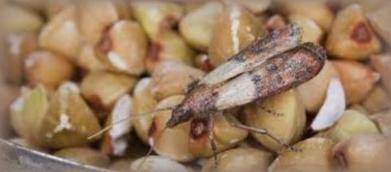
Indianmeal moth can eat and attack a wide variety of grains, plants, and other products consumed by humans.
The moths can feed on cereal, birdseed, plant-based dry pet food, nuts, dried fruits, rice, soup mixes, pasta, flour, bread, and spices.
According to pantry bug information from the University of Florida, wheat from northern Manitoba facilitates the moth’s development cycle.
The optional plant-based food products eaten and infested by the moth include almonds and American yellow corn.
However, maize meal and groundnuts slow the development cycle of the bug.
The Life cycle of the Indianmeal moth
The Indianmeal moth’s life cycle is characterized by four stages: egg, larvae, pupa, and adult. The eggs are located where grain or other human food supplies are stored.
The temperatures around the eggs should be more than 10 °C (50 °F) for them to develop. The eggs are light grey and range in length from 0.3mm to 0.5mm, and they are laid directly on the food.
The mature female can lay the eggs in clusters of 12 to 30 or singly, and the total number it lays at a time can be from 100 to 400 eggs.
The eggs hatch between the seventh and eighth day after being laid at 20 °C and between the third and fourth day at 30 °C.
This marks the beginning of the larvae stage. In a few hours, they immediately disperse and establish their food source.
The larval development can take six to eight weeks if the temperatures are between 18 °C and 35 °C.
Depending on the temperatures and the food source, the number of larval instars can vary between five and seven.
The more mature larvae consume grain germ, while the newly hatched consume grain. The fully developed larvae are capable of spinning webs that are left as trails of their travel.
They can also create threaded cocoons. The pupal stage is characterized by dormancy because the larva transforms into an adult moth.
The stage lasts between 15 and 20 days at 20 °C and between 7 and 8 days at 30 °C.
The pantry bug information from the University of Minnesota suggests that the adult stage of the Indianmeal moth is meant for mating and renewing the pantry bug’s life cycle.
Mating and egg-laying usually occur three days after the adult emerges. The bug’s life cycle can take about 30 to 300 days.
However, the typical cycle lasts about 50 days, while optimal conditions can result in a short 28 days.
The cold winter months delay the development of individual stages, which can result in 300 days of diapause.
Can Indianmeal moth harm when eaten?
Consumption of the Indianmeal moth is not as harmful to humans as it is to other pantry bugs. As another article determined, pantry moths cannot harm humans even when eaten.
Humans can accidentally or unknowingly ingest the eggs, larvae, or pupa of moths through a wide range of plant-based dried foods.
Such foodstuffs include bread, cereal, rice, pasta, flour, couscous, spices, nuts, and dried fruits.
They can also be consumed through chocolate, crushed red pepper, cookies, coffee substitutes, cocoa beans, and mangel wurzel.
They can infest commercial foodstuffs for pets, such as cats, dogs, and birdseed.
2. Sawtoothed grain beetles
This species of pantry bugs are scientifically known as Oryzaephilus surinamensis.
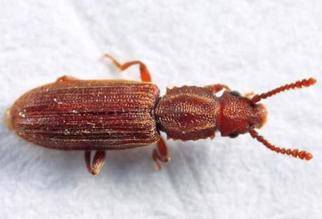
It is very common globally and infests plant-based products such as grains (such as rice and cereals), chocolate, tobacco, and drugs.
The species’ botanical name translates to “rice-lover from Surinam” because the first specimens studied were from Surinam.
Apart from feeding on plant-based foodstuffs in the house, such as dried nuts, seeds, cereals, and fruits, the pantry bug also feeds on dried meat and macaroni.
The life cycle of Sawtoothed grain beetles
The pantry bugs info on the beetle indicates that it has a lifespan of between six and ten months. Within their lifespan, the female can lay between 43 and 285 eggs, usually deposited on foodstuffs.
The most favorable range of temperatures for the development of the larva in the eggs is between 80 °F and 85 °F (27 °C and 29 °C). If such conditions are constant, the eggs can hatch in three to five days.
The larval stage is characterized by the emergence of whitish-yellow larvae with brown heads reaching up to 3mm in length.
The larvae crawl freely within the foodstuffs while feeding on grain debris or grain kernels damaged by other pantry bugs.
If they are large enough, they can also bore into the grain. The larval stage accounts for the greatest damage to the foodstuffs stored in the pantry. Before transforming into pupae, the larvae molt 2 to 4 times.
The pupae stage is characterized by dormancy. In preparation for the pupation period, the larvae construct coverings that resemble cocoons using grain debris. The adult Sawtoothed grain beetle emerges after about seven days.
The average lifespan of an adult Sawtoothed grain beetle is between six and ten months. However, some can have a lifespan of close to three years.
Within the adult stage, the pantry bugs may move out to seek new food sources, which are also their preferred breeding places.
The bugs can nibble on people’s skin in places with severe infestations.
Can Sawtoothed grain beetles harm when eaten?
The pantry bugs info provided by health and safety researchers from the University of Minnesota indicates that consuming the Sawtoothed grain beetle is not harmful to human health.
This pantry bug is not harmful if eaten. However, in severe infestations, when the adult bugs nibble on people’s skin, the bites are also not harmful.
This occurs when people consume dried foodstuffs in their pantry that have not been adequately sealed in their containers.
The bug may also find its way into the pantry from the processing and storage facilities.
3. Drugstore beetles
Drugstore beetles are common globally, but their abundance is concentrated in warmer places or regions or within heated structures in temperate climates.
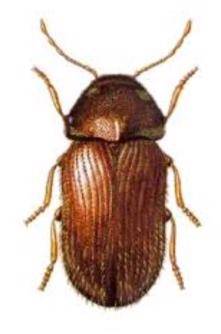
The pantry bug is scientifically known as Stegobium paniceum.
The drugstore beetle is commonly called the biscuit beetle or the bread beetle.
It infests and eats a wide variety of plant-based products that have been dried.
Drugstore beetle also has a habit of consuming prescription drugs, hence its name.
While in the pantry, it feeds and infests flour, bread, dry mixes, cookies, spices, and sweets.
They also infest and consume non-food materials like leather, hair, horn, wool, and museum specimens. They can bore into wooden objects, books, and, in some cases, lead sheets, aluminum, or tin foils.
The life cycle of the drugstore beetle
The pantry bugs info from the University of Florida states that the adult drugstore female beetle can lay close to 75 eggs within the foodstuffs.
The larval stage lasts between four and twenty weeks, depending on the quantity and type of food source. Drugstore beetles’ larvae crawl within the food while feeding.
When the larvae are fully developed, they build a cocoon and transform into a pupa. The pupation stage is also characterized by dormancy for about 12 to 18 days.
The adult drugstore beetles can live between 13 and 65 days. Even though the average lifespan of an adult drugstore beetle should be less than 2 months, some may live for 7 months.
This is because their lifespan and life cycle are dependent on the prevailing temperature and the type and quantity of food source. The standard temperature for the bug’s development is between 15 °C and 34 °C (60 °F and 93 °F).
The optimal conditions for its development are about 30 °C (85 °F) and a relative humidity between 60% and 90%.
Can the drugstore beetle harm humans if eaten?
Just like other pantry bugs, the drugstore beetle is not harmful to humans if eaten.
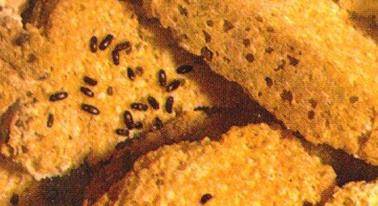
People may accidentally consume eggs, larvae, pupae, or adult bugs from whole and processed grains and vegetable products.
Beans, flour, rice, bread, pasta, cereals, tea, spices, and tobacco are among the infested foods that people may eat the bugs.
Freezing the infested foodstuffs below -20 degrees Celsius can eliminate the bug in all developmental stages.
4. Granary, rice and maize weevils
The weevil, also known as the maize weevil, is scientifically known as Sitophilus zeamais. In the United States, it is also known as the greater rice weevil.
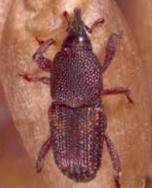
Maize weevil is commonly found in tropical regions globally and in the United States.
It attacks and eats standing and stored maize and other cereals like rice and wheat.
Other cereals that are common targets include sorghum, barley, oats, rye, peas, buckwheat, and cottonseed.
The weevil also infests and consumes stored processed cereals such as cassava, milled grains, pasta, and stored fruits such as apples.
This shows that this species of bug is the most dominant and destructive pest globally.
The life cycle of a maize weevil
The bug takes an average of 36 days to fully develop. When the female is fully mature and ready to lay fertilized eggs, the weevil bores a hole through the preferred grain surface and deposits a small white oval egg.
The female weevil then covers the bored hole using a waxy secretion as the ovipositor is removed, thus creating a plug.
The plug hardens, leaving a small raised notch on the seed’s surface.
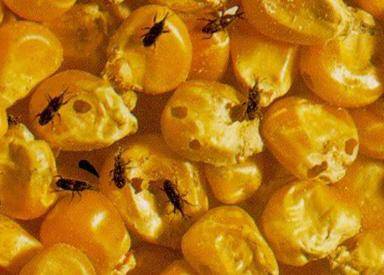
The female weevil only lays a single egg per grain.
The egg hatches and releases a white larva without legs.
It remains within the hole inside the seed while feeding on it.
The larvae will remain inside the seed until it pupates, and the pupa will remain inside the seed until it has fully transformed into an adult maize weevil.
The adult weevil creates an exit hole through the seed to emerge. One female maize weevil is believed to lay between 300 and 400 eggs within her lifetime.
Adults live between five and eight months. Conducive conditions for breeding are temperatures ranging from 15 °C to 34 °C and a relative humidity of 40%.
When the adult maize weevils emerge from the grain, the females release sex pheromones after moving to a higher surface. This attracts the males to begin mating.
How to get rid of different pantry bugs
Many people who have pantry bug infestations in their homes and kitchens wish they could get rid of them once and for all.
The good news is that some methods and products can eliminate the infestation.
The following are the best practices you can apply to defend your home against pantry bugs:
How to get rid of the Indianmeal moth
While at the store, inspect the packages of the foodstuffs before purchasing them. Look for broken seals and holes. Older products may give eggs more time to hatch.
When you bring the products home, check for damage or holes within the internal packaging.
After that, apply the following ways of controlling Indian meal moths in your house.
- Trap and monitor Indianmeal moths using sticky traps from products like a Pantry Pest Trap. In fact, pantry traps are effective because they help interrupt the breeding of the bugs.
- You should then store your foodstuffs in sealed containers to avoid entry of the moth.
- If you discover an infestation in your stored food products, toss it away while sealed in a recyclable grocery bag.
- If you do not want to throw away the infested foods, treating them can be an option. The first option is to freeze them for seven days. Microwaving them for five minutes can kill the infestation.
- The next step is to thoroughly disinfect your pantry and home using products like Catchmaster Pantry Pest and Moth Traps and Terro Pantry Moth Traps.
Getting rid of the Sawtoothed grain beetles
- While at the store, inspect the packages of the foodstuffs before purchasing them. Look for broken seals and holes. Older products may give eggs more time to hatch.
- When you bring the products home, check for damage or holes within the internal packaging.
- Store your dried foodstuffs in sealed bags and containers.
- If there is an existing infestation, identify and dispose of the affected products.
- If you do not want to dispose of the affected foodstuffs, you can also freeze them for six to seven days.
- You can also consider fumigation. Depending on the severity, this procedure can take up to six months.
- You can use products like Black Flag, Terro, and Catchmaster.
Getting rid of the Drugstore beetles
- While at the store, inspect the packages of the foodstuffs before purchasing them. Look for broken seals and holes. Older products may give eggs more time to hatch.
- When you bring the products home, check for damage or holes within the internal packaging.
- You should then store your foodstuffs in sealed containers to avoid entry of the moth.
- If you discover an infestation in any of your stored food products, toss it away while sealed in a recyclable grocery bag.
- Treating the infested foodstuffs can be an option if you do not want to toss it away.
- The first option is to freeze the foodstuffs for 16 days. Microwaving them for 7 minutes can kill the infestation.
- Chemical products for removing the bugs include JF Oakes Pro Pest Pantry Moth & Beetle Trap and Pro-Pest Pantry Moths & Beetle Trap.
Getting rid of the Granary, rice, and maize weevils
- While at the store, inspect the packages of the foodstuffs before purchasing them. Look for broken seals and holes. Older products may give eggs more time to hatch.
- When you bring the products home, check for damage or holes within the internal packaging.
- You can freeze the infested food products to kill them.
- An easily applicable home remedy is to purchase neem or bay leaves and put them inside containers with foodstuffs that are prone to contamination.
- Sprinkling clove leaves around the pantry area can fight off the infestation because the bugs hate them.
- Keeping an open matchbox near the prone foodstuffs will fight the infestation because weevils dislike the smell of sulphur.
- Fumigation can also help in fighting the infestation. You can use Eco Defense Pest Block, Able Catch Pantry Pest Trap, and Greenway Pantry Patrol Insect Trap.
FAQs on whether Pantry Bugs are Harmful if Eaten
Where do pantry bugs come from?
They originate from food processing and storage facilities. They can also enter your home by flying, crawling, or attaching themselves to your clothes.
How do you keep bugs out of flour?
The best method is to seal the container with the flour completely.
What are the little flying bugs in my pantry?
They are primarily Indianmeal moths and weevils.
Do
Do weevils carry diseases?
No study has shown that they carry diseases.
Can you eat rice with bugs in it?
There is no health risk when you eat rice with bugs in it.
Do you use flour with weevils in it?
Yes, you can use it if you don’t mind their presence.
You may actually be eating weevils in your food. Check this out


As a homeowner, I am specifically keen on home improvement. I am passionate about homes, yards, and home improvement. I blog on home ideas and reviews on solutions that make homes better.